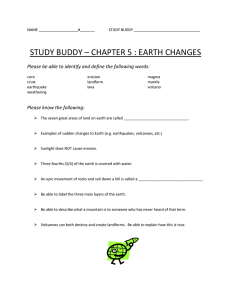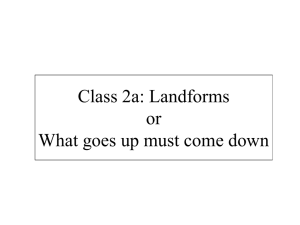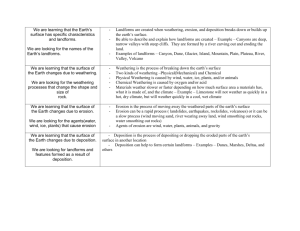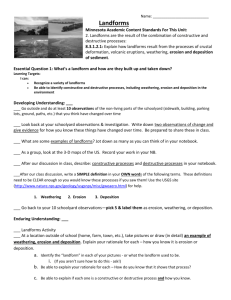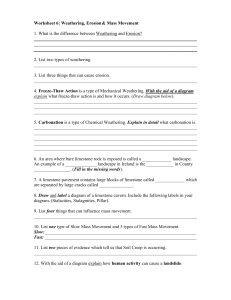What is geography?
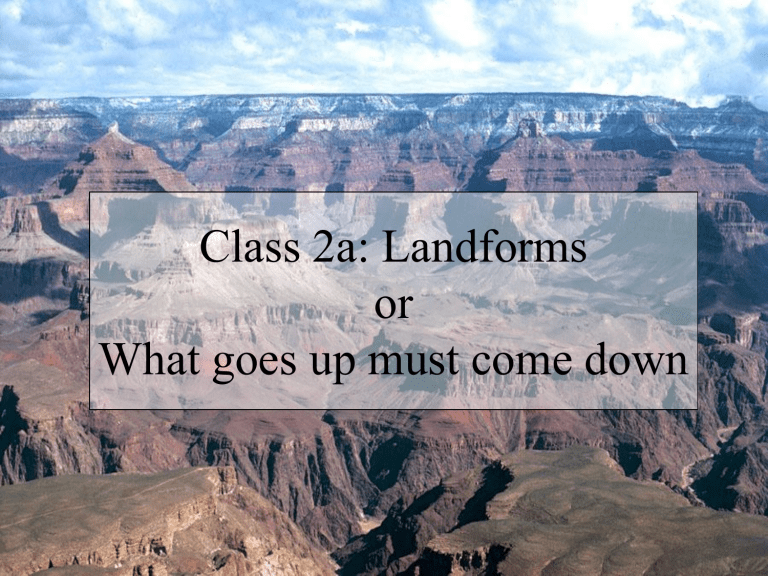
Class 2a: Landforms or
What goes up must come down
Today’s class
• "The summit of Mt. Everest is marine limestone."
• Tectonic forces
– Earthquakes, volcanoes
– Diastrophism
• Gradational processes
– Weathering, mass wasting
– Erosion/deposition: water, waves, wind
• Examples from CA, SW Asia,
Oceania
Rock cycle
• Your responsibility!
• Differences between igneous, sedimentary, metamorphic
• Examples of each
Plate tectonics
• Theorized in 1912; proven after
WWII
• 12 large plates (lithosphere) float on liquid rock (asthenosphere)
• 200 million years ago, all one continent (Pangaea)
Plate tectonics
• Divergent boundaries
– Generally mid-ocean
– Underwater volcanoes, few quakes
• Convergent boundaries
– Usually near continental edges
– Violent volcanoes near ocean, strong quakes
• Transform boundaries
– No volcanoes, mild to strong quakes
Earthquakes
• Stress relief via crust movement
• 500,000 per year; 800 felt
• Seismic waves of energy
– P-waves or primary waves (Slinky)
– S-waves or secondary waves (up and down)
• Earthquakes don't kill people, buildings (and gas mains) do
Bam, Iran
12/26/2003
Diastrophism
• Your responsibility!
• Folding vs. faulting
• Escarpment, rift valley, faultblock mountain (Sierra Nevada)
Volcanism
• Pressure on molten rock
• Composite volcanoes
– Violent and explosive
– Along subduction zones
– Relatively hard to predict
• Shield volcanoes
– More calm and constant
– Along divergent boundaries or at hot spots
– Relatively less dangerous
Mt. St. Helens
5/18/1980
Mt. St. Helens
5/18/1980
Mt. St. Helens
5/18/1980
Krakatoa, Indonesia
8/26/1883
Krakatoa, Indonesia
8/26/1883
Gradational processes
• Weathering
– Chemical vs. physical
• Mass movement
• Erosion/deposition
– Water (rivers, oceans)
– Ice (glaciers)
– Wind
Weathering
• Most mountains are going down faster than they’re going up
• Mechanical weathering breaks rocks into smaller pieces
– Frost action
– Salt crystals
– Roots
– Exfoliation
• Rock chemistry does not change
Frost action
Weathering
• Chemical weathering changes the chemistry of rocks
– Oxidation (exposure to oxygen)
– Hydrolysis (exposure to water)
– Carbonation (exposure to carbon dioxide)
• Warmth and water encourage chemical reactions
• Weathering loosens rock particles, creates soil
Oxidation
Carbonation
Carbonation:
Karst
Carbonation:
Sinkholes
Carbonation:
Sinkholes
Erosion and deposition
• Erosion carries particles away
• Deposition deposits them
• Running water
– Constant water, floods
– Most important landform agent in deserts
– Floodplains, levees, and deltas
– Arroyos and alluvial fans
Levee
Floodplain
Delta
MO
IL
Alluvial fan
Wadi (Oman)
Arroyo (TX)
Glaciers
• Rivers of ice
• Carve out landforms from mountains
– Glacial troughs
– Fjords
– Cirques
• And deposit material when they leave
– Outwash plain
– Moraines
Glacial landforms
Kyrgyzstan
Tajikistan
Glacial landforms: California
Glacial landforms: Iowa
Waves and coastlines
• Waves transfer energy, don’t move water
• Energy moves particles down the coast
(longshore current)
• Newer coastline=erosion
• Older coastline=deposition
• Barrier reef: only organically formed landform
Longshore current
Pacific Palisades
Acapulco
Erosion vs. deposition
Cancún
Great Barrier Reef
Great Barrier Reef
